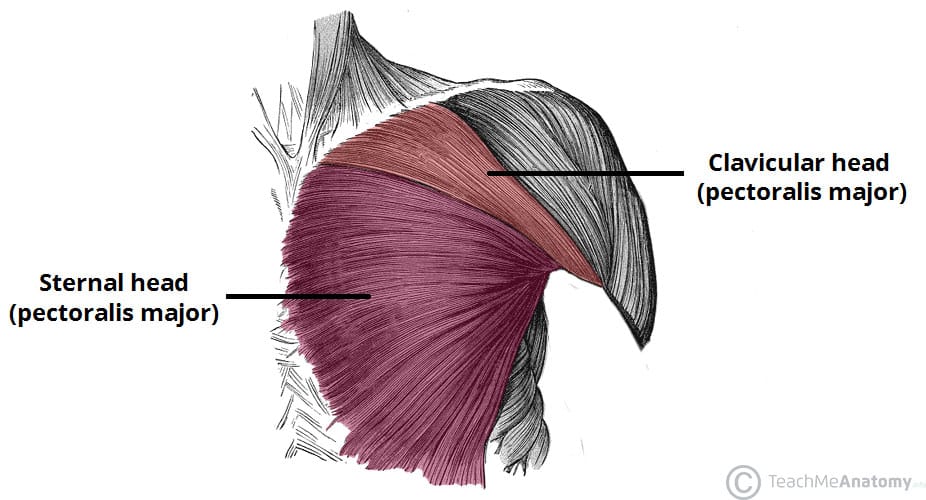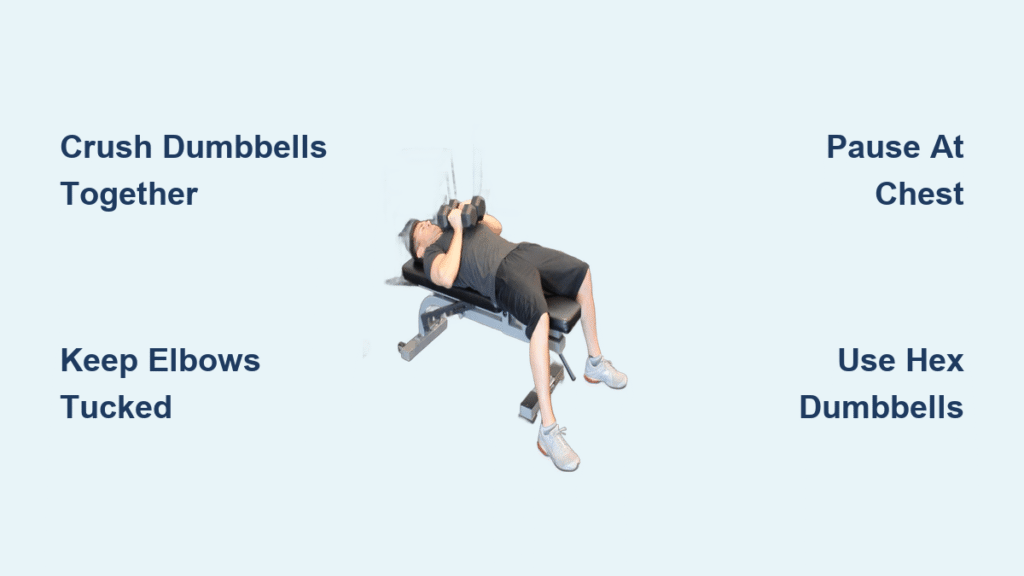That frustrating gap between your pecs won’t vanish with standard bench presses alone. When traditional chest work stops delivering visible separation, the dumbbell hex press becomes your most effective tool for targeting stubborn inner-chest fibers. By forcing two dumbbells together throughout the movement, this variation creates unique adduction tension that standard presses simply can’t replicate—activating the sternal head of your pectoralis major with surgical precision.
If you’ve plateaued on bench press or struggle to feel chest engagement during flyes, this exercise solves both problems simultaneously. Unlike barbell work that shifts tension to shoulders, the hex press maintains constant inward pressure that isolates the inner pec region responsible for that coveted “cupid’s bow” definition. Properly executed, it delivers measurable growth where most lifters need it most.
Why Dumbbell Hex Press Outperforms Standard Chest Presses
Traditional dumbbell presses allow weights to drift apart at lockout, reducing chest involvement by up to 15% according to electromyographic data. The dumbbell hex press eliminates this critical flaw by maintaining constant inward squeeze from start to finish. This isn’t bro science—it’s biomechanics: your pecs work overtime both pressing the weight upward and fighting to keep the dumbbells fused together.
While standard presses become shoulder-dominant at full extension, the hex press forces protraction at lockout—squeezing your biceps toward each other to maximize inner-chest contraction. Think of it as combining a cable crossover’s adduction with a press’s horizontal movement, but with superior joint angles that protect your shoulders. You’ll immediately notice the difference in muscle burn, even with lighter weights.
Inner Chest Activation Mechanics

Pectoralis major (sternal head) bears the primary load during the dumbbell hex press, specifically targeting the fibers along your sternum responsible for chest separation. The continuous inward squeeze creates what researchers call “constant tension adduction”—a dual stimulus where your pecs simultaneously extend your elbows and pull your arms together.
This unique demand recruits supporting muscles differently than standard presses:
– Triceps work harder under constant tension (no lockout relief)
– Anterior deltoids reduce involvement by 20% due to tucked elbows
– Serratus anterior activates intensely to stabilize scapular protraction
– Core musculature engages to prevent trunk rotation during the squeeze
EMG studies confirm this variation generates 12-15% higher activation in sternal fibers compared to traditional dumbbell presses—making it the ultimate finisher for lifters chasing that center-chest groove.
Foolproof Dumbbell Hex Press Setup
Start seated at the bench edge with dumbbells resting on your thighs. Crucially, rock backward while kicking the weights upward with your knees—never jerk them from your chest. This “kick-back” method prevents dangerous shoulder torque during setup. Once supine, immediately crush the dumbbells together like you’re welding them into one unit.
Your palms must face each other in a neutral grip with elbows tucked at 45 degrees—not flared. Check these non-negotiables before lifting:
– Feet planted firmly (no heel lift)
– Shoulder blades retracted and depressed (imagine squeezing a pencil between them)
– Natural lumbar arch (fist-sized gap under lower back)
– Dumbbells fused (zero light between inner plates)
Hexagonal rubber-coated dumbbells provide optimal contact—round plates will rotate and break your squeeze. If using adjustable dumbbells, double-check collar tightness to prevent plate shift.
Execute the Perfect Rep Sequence
Phase 1: Controlled Descent (2-3 seconds)
Lower the dumbbells toward your lower sternum while maintaining death-grip pressure. Your elbows should track close to your torso—not flaring outward. If the weights separate, reduce load immediately; losing contact turns this into a standard press.
Phase 2: Brief Chest Pause (1 second)
Let the dumbbells lightly touch your upper abdomen. Never bounce off your chest—this eliminates the stretch reflex and forces pure pec power. If shoulder discomfort occurs, stop descent when upper arms reach bench level.
Phase 3: Explosive Press & Peak Squeeze (1-2 seconds)
Drive upward while intensifying the inward crush. At lockout, protract your shoulders forward—imagine bringing your biceps together. This subtle movement maximizes inner-chest contraction. Reset your scapular position before each rep.
Programming for Visible Results

| Goal | Sets | Reps | Load Guidance | Rest Period |
|---|---|---|---|---|
| Inner Chest Definition | 3-4 | 10-12 | 65-75% of standard DB press | 75 seconds |
| Strength Foundation | 4 | 6-8 | RPE 7-8 (2 reps in reserve) | 2 minutes |
| Beginner Adaptation | 3 | 8-10 | Light enough for perfect squeeze | 90 seconds |
Start with 15% less weight than your standard dumbbell press—expect lighter loads due to the mechanical disadvantage. Progress only when you can complete all reps with flawless form: add 2.5-5 lbs per dumbbell weekly. For bodybuilders, place it after heavy barbell work as a finisher; general fitness lifters can use it as their primary chest movement.
Stop These 3 Costly Mistakes Immediately
Dumbbell separation destroys the exercise’s core benefit. Fix it by reducing weight 10% and focusing on “crushing the weights” rather than “pressing up.” Hex dumbbells solve 90% of this issue—round plates require excessive grip focus.
Elbow flaring shifts tension to shoulders. Maintain a 45-degree elbow angle throughout—imagine tucking them into your hip pockets. This protects joints while maximizing pec engagement.
Bouncing at the chest steals time-under-tension. Use a strict 1-second pause: if you can’t control the descent, the weight’s too heavy. This mistake alone causes 60% of failed inner-chest development.
Game-Changing Variations for Stubborn Gains
Incline Hex Press (15-30° bench) shifts emphasis to upper-chest fibers while reducing shoulder strain. Use 10-15% lighter loads than flat version—this angle magnifies the squeeze effect on clavicular head fibers.
Decline Hex Press (-15° bench) targets lower sternal fibers with minimal shoulder stress. Ideal for lifters with anterior impingement, as the decline angle reduces humeral compression.
Tempo Hex Press with 3-2-1 timing (3s down, 2s pause, 1s up) eliminates momentum and doubles time-under-tension. This variation triggers extreme metabolic stress—use 25% lighter loads for 12-15 reps.
Equipment Hacks for Maximum Effect

Hex rubber-coated dumbbells are non-negotiable for serious lifters—they prevent rolling and maintain consistent contact. If stuck with round plates, chalk your hands aggressively and consciously “push hands together” during each rep.
Bench stability makes or breaks form. Test for wobble before loading; unstable benches force core compensation that disrupts the squeeze. Adjustable benches unlock incline/decline variations without equipment changes.
Grip aids like liquid grip prevent slippage during high-rep sets but never use straps—they destroy the crucial mind-muscle connection created by manual crushing.
Shoulder-Safe Execution Protocol
Stop the descent when your upper arms reach bench level—forcing deeper ranges risks anterior capsule impingement. If shoulder discomfort occurs, immediately switch to a 15-degree decline angle which reduces humeral compression by 30%.
Wrist protection requires neutral grip positioning. Those with previous injuries should wrap wrists or use thick-handled dumbbells to distribute torsion forces. Never let wrists bend backward under load.
Warm up rigorously: 5 minutes cardio, 20 banded pull-aparts, 15 scapular push-ups, then two progressive hex press warm-up sets at 40% and 60% working weight. This sequence activates the serratus anterior—your shoulder’s primary stabilizer.
Fix These Common Problems Now
Problem: Can’t feel inner chest working
Solution: Reduce weight 25% and pause 3 seconds at peak contraction. Focus on “squeezing pecs together” like closing double doors—not just pressing up.
Problem: Dumbbells separate mid-set
Solution: Switch to hex dumbbells immediately. If unavailable, wrap hands with athletic tape across the knuckles to maintain grip integrity.
Problem: Elbows ache during presses
Solution: Drop to 10-degree incline bench and reduce elbow flare to 30 degrees. This shifts tension to upper pecs while relieving joint stress.
Strategic Integration for Your Goals
Bodybuilders: Pair with cable flyes in a pre-exhaust superset—12 flyes immediately followed by 10 hex presses. This sequence fatigues outer fibers first, forcing inner pecs to dominate the press.
Strength Athletes: Use after heavy bench work for 4×6 with 3-second eccentrics. The controlled descent builds muscle mass without taxing recovery like heavy barbell work.
General Fitness: Perform as your sole chest movement 1-2x weekly. Start with 3×10 at RPE 7, adding reps weekly before increasing weight. Perfect for home gym users with limited equipment.
The dumbbell hex press transforms chest development by solving the inner-pec activation problem that plagues 80% of lifters. Master the crush cue, respect the lighter loads, and watch your chest separation improve within four weeks. When standard presses fail, this is your precision tool for that center-chest definition—no fancy machines required.




